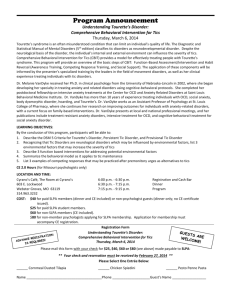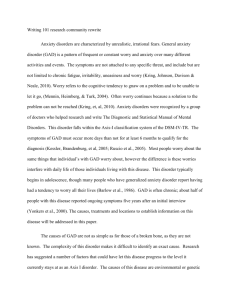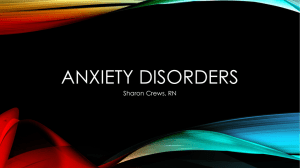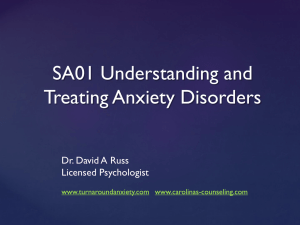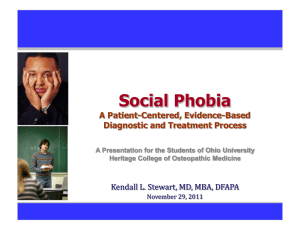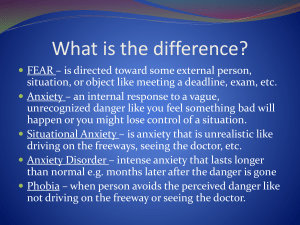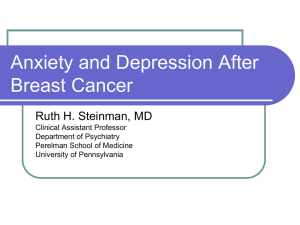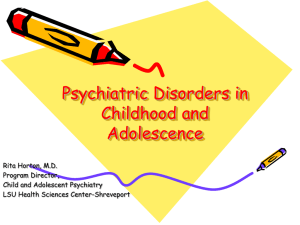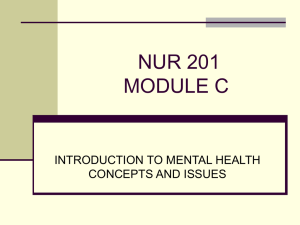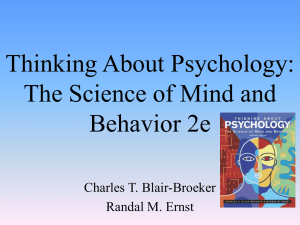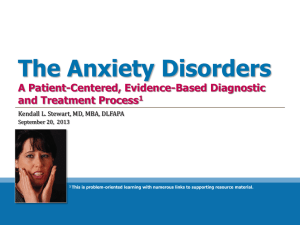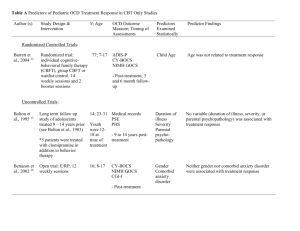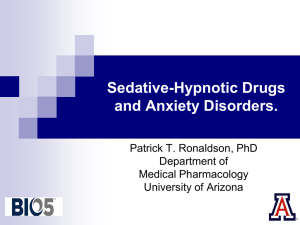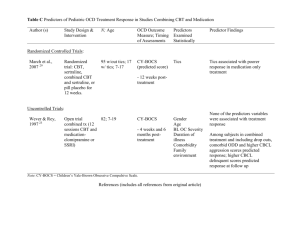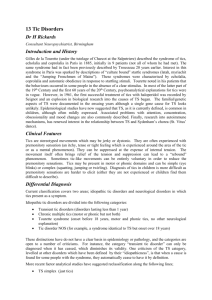Anxiety Disorders
advertisement
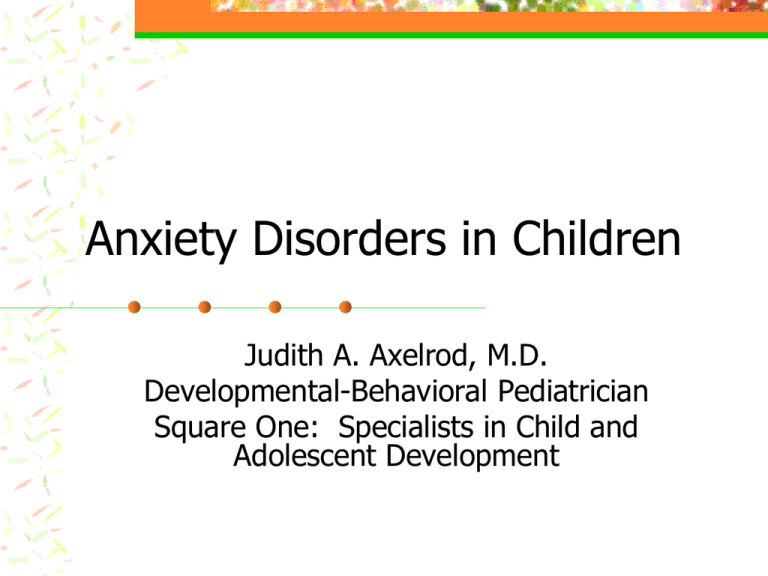
Anxiety Disorders in Children Judith A. Axelrod, M.D. Developmental-Behavioral Pediatrician Square One: Specialists in Child and Adolescent Development Childhood Anxiety Disorders • Most common emotional/behavioral disorder in childhood • Incidence 10-15% • • • • • • • • Generalized Anxiety Disorder Obsessive-Compulsive Disorder Separation Anxiety Adjustment Disorders Panic Attacks ADHD Tourette syndrome Autism spectrum disorders Anxiety • Apprehension of danger and dread • Accompanied by • • • • Restlessness Tension Rapid heart rate Shortness of breath • Unattached to a clearly identifiable stimulus As for you, my fine friend, you’re a victim of disorganized thinking. You are under the unfortunate delusion that simply because you run away from danger, you have no courage. You’re confusing courage with wisdom. --The Wizard of Oz, addressing the Cowardly Lion (1939) Case study B.F. is a sweet, loving, intelligent, honest youngster of 10 years who has an over developed sense of consciousness. He is sensitive and compassionate. He is distractible, intrusive, impulsive and very disorganized. Precision and accuracy are important to him. He is a worrier. He worries about floating off his bed into space. He understands that this is not a rational fear but he cannot stop this worry. He is afraid of becoming something other than himself (like in movies when characters change into something else). He is worried about getting “ cooties”. If he touches a girl, mother sometimes included, he must wipe off the “cooties.” At night he prays that people who have irrational fears will stop having these fears. Case study C.S. a 4 year old is a very sensitive, well behaved, anxious youngster who follows rules. He is a shy, needy child who asks a lot of questions. He is a worrier. He frequently asks if the power will go out. He talks about about death. He is fearful of being alone; he doesn’t like to go to his room alone. He brings everyone to his room to play. He has always been a shy youngster who would not respond to people who speak to him other than close family members. He talks while in stores however if someone directly speaks to him he stops talking. Social Phobia • Excessive fear in social situations where child is exposed to unfamiliar people/evaluation by others • Excessively self conscious/ shy • Tremendous concern about social failure/embarrassment/humiliation Selective Mutism • Children either talk minimally or not at all in certain settings or situations that are part of their daily lives (e.g., school). • Reflects underlying problems with anxiety • Often inadvertently reinforced by other individuals (i.e., parents, friends) in the child’s daily life (e.g., speaking for the child, permitting the use of nonverbal communication, etc.). • Considered an extreme form of social phobia Case study S.M. is an 11 year old who worries about the weather: tornados, storms, fire. She is frightened of dark clouds. She worries if the electricity is turned off and if chores were completed. She is fearful of scary movies, the News and she is easily scared. Mother must be careful of what is said around Sarah because of her worry. Sarah is anxious and clingy to her mother. She has a prayer ritual; it takes her 15 minutes to complete her evening prayers. Case study • C.G. is a 12 year old who has specific routines for getting dressed and going to bed. She repeatedly hand washing, such that her hands bleed. She brushes her teeth with repetitive motion of putting the brush under water. She steps forward and back. She turns light switches on and off. She opens and closes drawers. She picks things off tables or floors with a specific repetitive pattern. Her clothing must be put out in a certain order or this must be repeated. It takes her a long time to get dressed. She erases a lot. She is not turning in her assignments and is having hesitation abut going to school. She is afraid to start the school day. Obsessive-Compulsive Disorder • Characterized by patterns of repetitive behaviors, rituals, and obsessive thinking that interfere with daily activities. • Typically diagnosed between the ages of seven and twelve years. • Occurs approximately in 1 in 200 children in the United States. • Caused by an aberrant function of brain circuitry, possibly in the part of the brain called the striatum. Obsessive-Compulsive Disorder • Obsessions are intrusive and persistent thoughts or ideas that cause distress. • Compulsions are repetitive behaviors that are done to alleviate the obsessions. • Not performing the rituals causes anxiety. Generalized Anxiety Disorder • Children with Generalized Anxiety disorder are chronic worriers. They seem to be on edge about something. These children have a difficult time relaxing and often have trouble falling to sleep. Physical symptoms often accompany the worry, such as headaches, feeling shaky or sweating. Young children with Generalized Anxiety Disorder can also suffer from separation anxiety. As children get older, depression can accompany the feeling of generalized anxiety. Similar to other anxiety disorders, Generalized Anxiety Disorder typically responds well to cognitive-behavioral strategies that are developed while working with a psychotherapist. Sometimes medical treatment of anxiety is warranted. Tourette Syndrome • one year history of multiple motor and phonic/vocal tics. Tics are sudden, intermittent, involuntary contractions of muscles that produce movements or sounds. Phonic or motor tics may appear simultaneously or at separate times. Tics may occur many times during the day, nearly every day or intermittently. Tourette Syndrome is usually life-long, although there are periods of remission that last from weeks to years. The frequency and severity of the symptoms are variable and may diminish during adolescence and adulthood. Sometimes symptoms disappear entirely, usually after early adulthood. Tourette Syndrome is associated with a variety of behaviors and learning difficulties. The most common associated finding is Attention Deficit Hyperactivity Disorder. Symptoms of Attention Deficit Hyperactivity Disorder typically precede the onset of phonic and motor tics by two years. In addition, approximately 30-40% of individuals with Tourette disorder have obsessive-compulsive behaviors. Thirty percent of individuals with Tourette syndrome have mood lability, described as high levels of anxiety, emotional lability, fearfulness, low frustration tolerance, aggressiveness and impulsivity. NONVERBAL LEARNING DISORDER • Difficulties with nonverbal problem solving. • Visual, spatial organization and tactile perceptual skill defects. • Math is a specific and significant academic challenge • Significant problems adapting to new or complex situations. • Weakness in social perception and social judgment • At risk for internalizing psychological disorders such as depression and anxiety. • Often individuals with this profile exhibit social withdrawal and can become more socially isolated as they get older.

